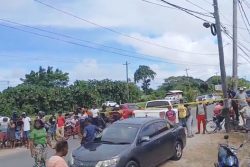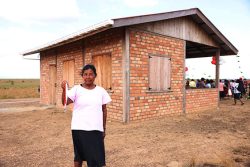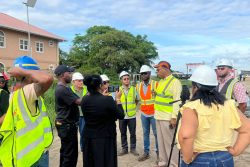The trafficking, exploitation and imprisonment of women and girls in our country’s interior is real. The everyday violations they face are real, and though the national data might appear minimal, this problem is anything but trivial.
Just last month I sat across the room from a young human trafficking survivor who was sharing her story. She “took a chance” and went into the gold bush but found that she had no choice in determining whether she worked as a shop attendant or a sex worker. For months she was powerless, voiceless and a victim of frequent violence and before she was rescued everyday presented fresh opportunities for her to be violated.
She was one of many victims trapped in an arrangement they had neither the means nor the resources to get out of, not unless someone intervened. Girls her age, and some much younger, were trading sex for money and gold they never saw. They had no freedom to move around and were restricted from communicating with people, with the exception of potential male customers.
 Trafficking in Persons (TIP) is a grave violation of human rights and sexual exploitation is the most common form of human trafficking. The lack of localised data and specific research makes it difficult to understand the real scope of the problem, but based on the cases which have been documented the majority of local victims are girls no older than age 20. In fact, some are children, still too young to consent to sexual relations.
Trafficking in Persons (TIP) is a grave violation of human rights and sexual exploitation is the most common form of human trafficking. The lack of localised data and specific research makes it difficult to understand the real scope of the problem, but based on the cases which have been documented the majority of local victims are girls no older than age 20. In fact, some are children, still too young to consent to sexual relations.
Indeed, there are older girls over age sixteen and women who are consensually working in the interior as sex workers but they too are abused and exploited. There are women in the commercial sex industry with very little personal power who find it difficult to escape exploitative situations.
These are crimes we downplay on the assumption that these girls are “hustling in the bush” and can get out anytime. It’s no surprise then that Human Services Minister Jennifer Webster so indifferently referred to them during her budget debate speech earlier this week as “alleged victims.”
But the teenager I met recently was no alleged victim. She was a real victim with a real story—a young girl who was exploited because she is poor, without adequate education and vulnerable.
While we sit around and debate whether these girls and women have willingly agreed to engage in sex work or whether they were coerced into such activities, a large majority of them remain exposed to numerous acts of brutality every day in mining communities.
For years, the US government has reported on the hidden devastation of human trafficking in Guyana and has called on the administration to step up the fight to combat TIP. Just as importantly, many local NGOs and activists have repeatedly shone a light on the terrifying abuses being perpetrated against the victims of human trafficking. But the official response has always been the same: the prevalence of human trafficking is low and the US government’s data is false.
On Tuesday, Minister Webster repeated the line about prevalence saying that repeated assessments have shown that “there is a low prevalence” of TIP. A few years ago Home Affairs Minister Clement Rohee made a similar declaration. In a report published by the TIP Ministerial Task Force in 2011, he made the following statement:
“The reports over the years have been clear that as a country Guyana does not have significant numbers of victims of trafficking in persons and the country’s authorities have made significant strides in increasing efforts aimed at preventing and addressing the phenomenon including protecting victims and vulnerable persons and in prosecuting perpetrators.”
But aside from the statements about low prevalence and the reported strides in increased efforts, there is hardly ever any new information on TIP from either minister and or the task force they are a part of. By law, Minister Rohee is required to publish regular figures on TIP and to keep the public informed on what is happening but no such reports have been forthcoming. How then are people supposed to get a sense of what is happening locally with TIP?
Previously, we waited every year for the US Statement Department to publish its global TIP report with country findings. More recently, we have been following the important work being done by the Guyana Women Miners Organisation (GWMO).
In its 2013 TIP report, the US State Department downgraded Guyana from Tier 2 to the Tier 2 Watch List for failing to demonstrate evidence of increasing efforts to hold trafficking offenders accountable. The administration rejected the findings and announced that it would no longer be cooperating with the US authorities. This means that when the 2014 report comes out later this year, the administration’s input would be missing.
It matters not whether two or three girls are rescued a year, one human trafficking victim is one too many. But we have not had one or two victims a year. In 2012, the GWMO was still in its early days and without any system in place to document evidence, but it had reported that four girls were rescued from the interior.
But in 2013, the organisation reported that 25 human trafficking victims were rescued from mining communities–of this number, 16 were under the age of 18. The cases were all reported to the authorities and the girls would have been interviewed and processed by the police, officials at the Child Care and Protection Agency and the Human Services Ministry. Similarly, information would have been passed on about the offenders and their last known whereabouts.
Yet only a few of the cases have reached the courts and as recently reported in the Stabroek News, many of them have collapsed due to the absence of the victims. But as GWMO President Simona Broomes pointed out, the girls are not appearing in court because they lack the resources to attend hearings.
Broomes has repeatedly condemned what she describes as a non-responsive criminal justice system that is failing TIP victims and she has accused the administration of being in denial about the problem. Her organisation has and continues to expose the harsh reality of human trafficking in the country and their efforts have not gone unnoticed.
While the government has not heeded Broomes’ call to partner with the GWMO to improve its response to human trafficking, the organization has been increasing its work and stepping up its advocacy. It’s because of them that we are aware of what is happening.
It’s because of the GWMO that public awareness is growing and the plights of trafficking victims are being highlighted. They have single-handedly exposed the denial and as Broomes would often say, “neglect.”
The GWMO is doing tremendous work and has made human trafficking numbers a reality but we can’t reasonably expect these women miners to fight this scourge of human trafficking alone. They have unearthed sufficient evidence to trigger concern and outrage, and it’s about time we move beyond the “prevalence assessments” and acknowledge that serious human rights violations are occurring in our mining communities.
Have a question or comment? Connect with Iana Seales at about.me/iseales.







